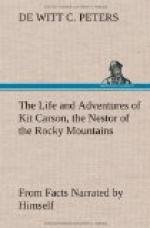When these horses broke down and began to die off, it was decided to be best to return to Fort Massachusetts in order to recruit and also to allow the Indians an opportunity to concentrate their forces, when another effective blow could be struck against them. On his return, Colonel Fauntleroy met, at the designated place, Lieutenant Beall, who had managed the affairs intrusted to him very much to his credit. Having once more consolidated his command, Colonel Fauntleroy retired to Fort Massachusetts, which he made, for a time, his head-quarters.
Kit Carson, the guide of this expedition, when afterwards speaking of it, says, “During the time our forces were in the field they were exposed to the most intense cold weather I ever remember experiencing. We were overtaken by several severe snow-storms which came near completely using us up.”
For the success that had so far attended the labors of this body of soldiers, the greatest amount of praise is due to their leader, who set a noble example to his men. During those hours when hardships and trials came thickest upon the command, all eyes were turned to the commander, and, as the result proved, with no lack of confidence. Kit Carson’s services were found to be invaluable. His long experience and untiring energy proved to be one of the best anchors of the goodly ship. We should not omit to state, in regard to the severity of the cold, that it was early in the morning, just before the break of day, that the cold was invariably found to be the most intense. During this time, it is the greatest wonder that the Mexicans did not perish, for but few of them had more than one blanket as a covering by night, and the remainder were but very little better provided for. When wood was plenty, and they were allowed so to do, they made large fires and laid down near to them to attempt sleep. After about one hour thus spent, they were routed out by being nearly frozen. Getting into close contact with the fires, they would thaw out and then were ready to make another endeavor to repeat the sleeping operation. In this manner they managed to live through each night, and on the following day they were, apparently, none the worse for wear. A person judging these men as he oftentimes sees them during the summer season, basking in the sunlight on the sunny side of their houses in New Mexico, would not, for an instant, suppose that they could undergo such hardships; and yet, they can do so, as the above example sufficiently proves, without allowing one murmur of complaint to escape their lips. With the regulars, who were amply supplied with blankets and buffalo robes, it would appear that they could have obtained sound sleep. But this too proved to be almost an impossibility. The heat of the man’s body, during the early and warmer part of the night, served to melt the icy covering of the mother earth just under him. When the cold increased, this was again frozen, rendering the portion of the body nearest to the ground almost benumbed. By frequently reversing the posture a little, some relief from suffering was obtained, but not sufficient to reach a degree which could be called comfortable, or, in the least, be claimed as desirable. Every member of this expedition can truthfully assert that they have experienced a foretaste of what the first symptoms of freezing to death must be.




